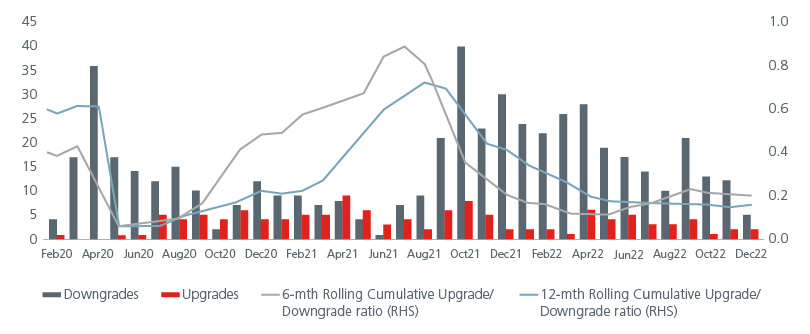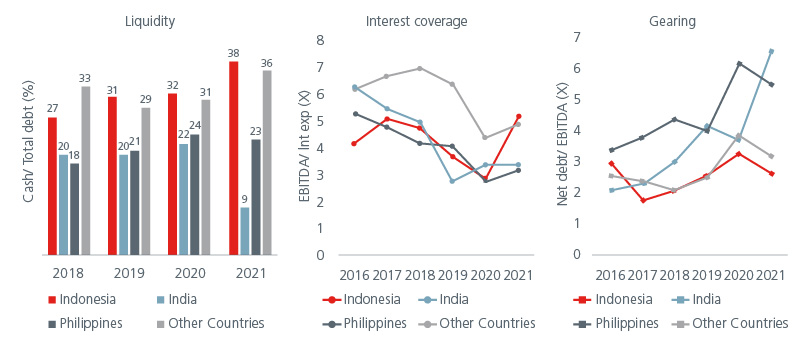Summary
The outlook for Asian High Yields is expected to improve, given peak default rates, the resilience of the Asian economies and stable credit fundamentals. A successful bond restructuring in China’s property sector could be a further catalyst. Meanwhile, attractive valuations raise the prospects of compelling total returns for long-term investors.
As the 10-year US Treasury yield reached a high of 4.2% in 2022 alongside rising inflation, a common remark among investors was that fixed income was finally delivering income.
This remark is probably a tad harsh for the Asian High Yield (AHY) sector, which has historically provided investors with attractive levels of income. Our analysis from end December 2000 to end December 2022 shows that AHYs had delivered higher returns for the same amount of risk compared to all other bond sectors as well as against Global, US and Asia ex Japan equities1.
While there were good reasons behind last year’s sell-off in the AHY sector – Chinese property concerns, Fed rate hikes, rising inflation, lower investor risk appetite - we offer seven reasons why AHYs are gradually returning to investors’ radars.
Back on the radar
1. Peak default rates. We believe that the default rate had peaked in 2022. The number of downgrades for AHY corporates has been trending lower since the end of 2021 (See Fig. 1.). With current valuations pricing in a lower default rate this year, a larger-than-expected fall in the default rate in 2023 could be a catalyst for the sector.
Fig. 1. Rolling 6-month and 12-month ratings actions trend for Asian high yield corporates

Source: JP Morgan, Moody's, S&P and Fitch Ratings, January 2023.
2. China’s re-opening. The end of China’s zero-Covid policy and the return of Chinese tourists are expected to benefit Singapore, Hong Kong, and Macau. This is likely to be supportive for select Macau gaming, Chinese industrials, and airlines credits within AHYs. The alignment in China’s covid management, economic and regulatory policies to revive economic growth should help to provide a floor for risk assets. China’s re-opening is also taking place at a time when US recession risk is rising, providing an important offset for Asian economies.
3. Property green shoots. Since November 2022, the Chinese central government has rolled out a series of policies to improve the liquidity positions of property developers and stabilise the sector. Policy support has continued in 2023. We have seen an encouraging uptick in home sales and prices in China’s property sector, which makes up approximately 15% of the JP Morgan Asia Credit Non-Investment Grade Index. Nevertheless, credit differentiation remains key. At the point of writing, we favour state-owned linked real estate names and select quality privately-owned enterprises. A well-received restructuring of defaulted or distressed bonds could be an important catalyst to restore investor appetite towards AHYs. We would be prepared to move down the credit curve within the Chinese property sector as the outlook for the sector improves.
4. Stable credit fundamentals. The credit fundamentals of AHY corporate issuers outside of China are relatively stable. The liquidity profiles of Indonesian corporates have been rising since 2018, as measured by the ratio of cash versus total debt on their balance sheets. Interest servicing ability among AHY issuers are at adequate levels while gearing appears manageable. See Fig. 2. Meanwhile, Asian economic and policy fundamentals look set to improve on the back of moderating inflation and peaking monetary policy rates. The IMF forecasts that emerging markets and developing economies will fare better than advanced economies in 2023. This should help to underpin Asian corporate fundamentals going forward.
Fig. 2. Credit fundamentals of AHY corporate issuers

JP Morgan, May 2022. Other countries include Hong Kong, South Korea, Macao, Malaysia, Mongolia, Singapore.
5. Tight supply. Only a few Chinese property developers have been able to tap the USD offshore market in 2023. Meanwhile, selected AHY issuers have taken advantage of less expensive sources of funding. For example, a few Indian renewables issuers have tapped the onshore bond market while several Indonesian high yield issuers have taken on local currency bank loans to buy back their dollar bonds. Negative net supply in 2023 is likely to help keep AHY bond prices supported.
6. Attractive valuations. Despite the rally in January, AHY valuations are still very attractive. Compared to other high yield as well as investment grade bond sectors, AHY’s spreads are still significantly above its 10-yr average2. The AHY market is currently offering double digit yields with an average credit quality of BB-3, offering a compelling risk-return trade-off compared to other bond sectors.
7. Short duration. While we believe the bulk of the Fed’s rate hikes are behind us, AHYs have the shortest duration (2.7 years)4 among the other bond sectors, making them relatively less vulnerable to rising interest rates. That said, rising rates could cause credit spreads to widen if investors are concerned about the issuer’s repayment ability. Hence, credit selection remains key.
Better from here
We believe that we are past the worst for AHYs. The outlook for the sector should improve on the back of China’s re-opening and the resilience of the Asian economies. Lower-than-expected default rates and successful bond restructurings in China’s property sector could be further catalysts. Meanwhile, the sector’s attractive valuations and short duration should provide investors with some buffer. Given the record number of downgrades in the last two years, there is room for selected sold-off credits to rebound. We believe that with prudent and active credit selection, long-term investors can take advantage of the emerging opportunities, and potentially enjoy not just attractive levels of income, but also compelling total returns.
Sources:
1 Bloomberg, Eastspring Investments, from end December 2000 to end December 2022, in USD, based on monthly data. Various markets are represented by following indices : Asian High Yield Bonds – JP
Morgan (“JPM”) Asia Credit Index (“JACI”) High Yield Index, Asian USD Bonds – JACI Asia Credit Index, Asian Local Bonds – Markit iBoxx Asian Local Bond Index, Global Government Bonds –
Citi World Govt Bond, US High Yield Bonds – Bank of America Merrill Lynch(“BofAML”) US High Yield, Global Emerging Market Bonds – JPM Emerging Markets Bond Index, Asian ex Japan Equities – Morgan
Stanley Composite Index (“MSCI”) Asia Ex Japan, Global Equities – MSCI AC World US$, US Equities – Standard & Poor 500 Index, US Treasuries represented by Citi US Broad Investment-Grade Treasury/Agency
Index.
2 Eastspring Investments, Bloomberg, as at 30 December 2022. US, EUR and Asian USD Investment Grade and High Yield corporates represented by ICE BofA US Corporate Index, US High Yield index, Euro Corporate
index, Euro high yield index, Asian Dollar Investment Grade index, Asian Dollar High Yield index respectively. EM USD Sovereign and Corporates are represented by ICE BofA US Emerging Markets External Sovereign Index and US
Emerging Markets External Debt Sovereign & Corporate Plus Index respectively.
3 Bloomberg, Eastspring Investments, BofAML, Citigroup, Markit iBoxx as 31 January 2023. As represented by the BofA Merrill Lynch Asian Dollar High Yield Corporate Index. There may be limitations to the use
of the index as a proxy for the past performance of the asset class. Historical performance are not indicative of future or likely performance.
4 Same as 3.
Singapore by Eastspring Investments (Singapore) Limited (UEN: 199407631H)
Australia (for wholesale clients only) by Eastspring Investments (Singapore) Limited (UEN: 199407631H), which is incorporated in Singapore, is exempt from the requirement to hold an Australian financial services licence and is licensed and regulated by the Monetary Authority of Singapore under Singapore laws which differ from Australian laws
Hong Kong by Eastspring Investments (Hong Kong) Limited and has not been reviewed by the Securities and Futures Commission of Hong Kong.
Indonesia by PT Eastspring Investments Indonesia, an investment manager that is licensed, registered and supervised by the Indonesia Financial Services Authority (OJK).
Malaysia by Eastspring Investments Berhad (200001028634/ 531241-U) and Eastspring Al-Wara’ Investments Berhad (200901017585 / 860682-K) and has not been reviewed by Securities Commission of Malaysia.
Thailand by Eastspring Asset Management (Thailand) Co., Ltd.
United States of America (for institutional clients only) by Eastspring Investments (Singapore) Limited (UEN: 199407631H), which is incorporated in Singapore and is registered with the U.S Securities and Exchange Commission as a registered investment adviser.
European Economic Area (for professional clients only) and Switzerland (for qualified investors only) by Eastspring Investments (Luxembourg) S.A., 26, Boulevard Royal, 2449 Luxembourg, Grand-Duchy of Luxembourg, registered with the Registre de Commerce et des Sociétés (Luxembourg), Register No B 173737.
Chile (for institutional clients only) by Eastspring Investments (Singapore) Limited (UEN: 199407631H), which is incorporated in Singapore and is licensed and regulated by the Monetary Authority of Singapore under Singapore laws which differ from Chilean laws.
The afore-mentioned entities are hereinafter collectively referred to as Eastspring Investments.
The views and opinions contained herein are those of the author, and may not necessarily represent views expressed or reflected in other Eastspring Investments’ communications. This document is solely for information purposes and does not have any regard to the specific investment objective, financial situation and/or particular needs of any specific persons who may receive this document. This document is not intended as an offer, a solicitation of offer or a recommendation, to deal in shares of securities or any financial instruments. It may not be published, circulated, reproduced or distributed without the prior written consent of Eastspring Investments. Reliance upon information in this document is at the sole discretion of the reader. Please carefully study the related information and/or consult your own professional adviser before investing.
Investment involves risks. Past performance of and the predictions, projections, or forecasts on the economy, securities markets or the economic trends of the markets are not necessarily indicative of the future or likely performance of Eastspring Investments or any of the funds managed by Eastspring Investments.
Information herein is believed to be reliable at time of publication. Data from third party sources may have been used in the preparation of this material and Eastspring Investments has not independently verified, validated or audited such data. Where lawfully permitted, Eastspring Investments does not warrant its completeness or accuracy and is not responsible for error of facts or opinion nor shall be liable for damages arising out of any person’s reliance upon this information. Any opinion or estimate contained in this document may subject to change without notice.
Eastspring Investments companies (excluding joint venture companies) are ultimately wholly owned/indirect subsidiaries of Prudential plc of the United Kingdom. Eastspring Investments companies (including joint venture companies) and Prudential plc are not affiliated in any manner with Prudential Financial, Inc., a company whose principal place of business is in the United States of America or with the Prudential Assurance Company Limited, a subsidiary of M&G plc (a company incorporated in the United Kingdom).













